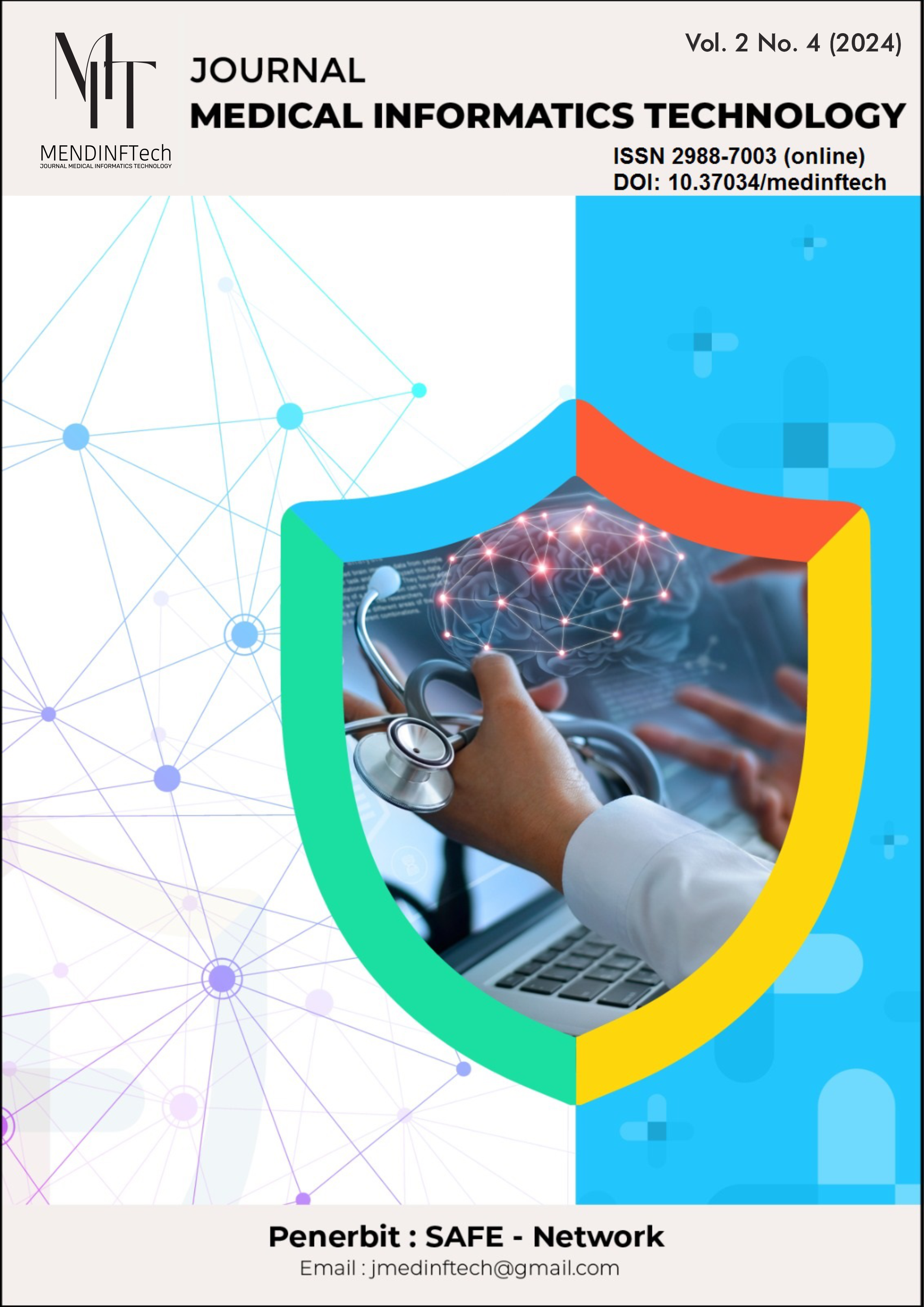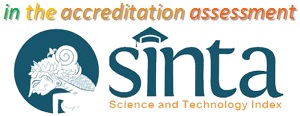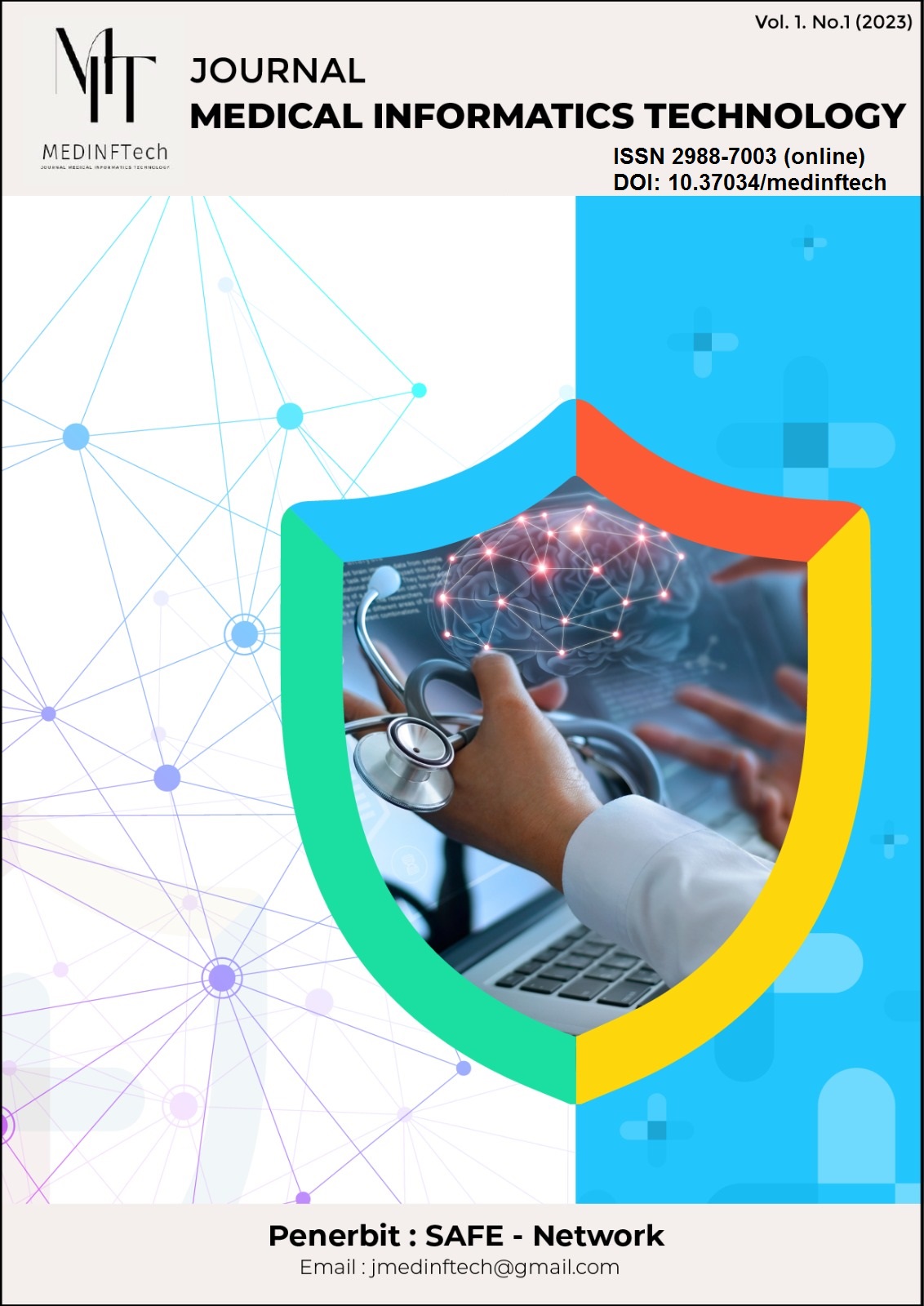Analysis of Service Quality on User Satisfaction in BPJS Kesehatan Website
DOI:
https://doi.org/10.37034/medinftech.v2i4.56Keywords:
Healthcare Organizations, Regression Analysis, Service Quality, User Satisfaction, WebsiteAbstract
BPJS Kesehatan plays a vital role in providing health insurance to millions of Indonesians, making it essential to assess the quality of service on their website to ensure efficient and accessible healthcare delivery. This study evaluates of service quality on user satisfaction with the BPJS Kesehatan website by analyzing 10 hypotheses related to information quality, system usability, and service effectiveness. The research employed a quantitative approach, utilizing a structured questionnaire and regression analysis with data from 32 respondents. Significant findings include a strong positive effect of service quality on system use (β = 0.928, p = 0.002) and a notable impact of system use on net benefits (β = 0.337, p = 0.014). The model's high R² value of 0.796 indicates that nearly 80% of the variance in net benefits is explained by the predictors, demonstrating that improved service quality and increased system use substantially enhance user satisfaction and perceived benefits. These results underscore the importance of focusing on service quality and user engagement to optimize outcomes from the BPJS Kesehatan website.
Downloads
References
BPJS Kesehatan, “Visi misi.” https://bpjs-kesehatan.go.id/#/profil?tab=visi-dan-misi (accessed Jul. 08, 2024).
Observatory of Public Sector Innovation, “Mobile JKN, Health Insurance Services in Your Hand - Observatory of Public Sector Innovation,” Observatory of Public Sector Innovation, Feb. 05, 2020. https://oecd-opsi.org/innovations/mobile-jkn-health-insurance-services-in-your-hand/ (accessed Jul. 12, 2024).
Md. U. H. Uzir, I. Jerin, H. A. Halbusi, A. B. A. Hamid, and A. S. A. Latiff, “Does quality stimulate customer satisfaction where perceived value mediates and the usage of social media moderates?,” Heliyon, vol. 6, no. 12, p. e05710, Dec. 2020, doi: 10.1016/j.heliyon.2020.e05710.
M. Ernawati, E. H. Hermaliani, and D. N. Sulistyowati, “Penerapan DeLone and McLean Model untuk Mengukur Kesuksesan Aplikasi Akademik Mahasiswa Berbasis Mobile,” IKRA-ITH Informatika: Jurnal Komputer dan Informatika, vol. 5, no. 1, pp. 58-67, Mar. 2021. [Online]. Available: https://journals.upi-yai.ac.id/index.php/ikraith-informatika/article/view/914.
M. Shim and H. S. Jo, “What quality factors matter in enhancing the perceived benefits of online health information sites? Application of the updated DeLone and McLean Information Systems Success Model,” International Journal of Medical Informatics, vol. 137, p. 104093, May 2020, doi: 10.1016/j.ijmedinf.2020.104093.
S. Pratiwi and M. I. Irawan, “Investigating the impact of website quality on user satisfaction in IDN Times News website,” Journal of Physics Conference Series, vol. 1842, no. 1, p. 012074, Mar. 2021, doi: 10.1088/1742-6596/1842/1/012074.
A. Yalçın and Ö. Çatlı, “A study on the electronic service quality of digital marketplaces in real estate marketing,” International Journal of Business and Economic Studies, Jun. 2024, doi: 10.54821/uiecd.1489012.
A. Rahman and Md. G. Muktadir, “SPSS: an imperative quantitative data analysis tool for social science research,” International Journal of Research and Innovation in Social Science, vol. 05, no. 10, pp. 300–302, Jan. 2021, doi: 10.47772/ijriss.2021.51012.
R. Ariyanto, E. Rohadi, and V. A. Lestari, “The effect of information quality, system quality, service quality on intention to use and user satisfaction, and their effect on net benefits primary care application at primary health facilities in Malang,” IOP Conference Series Materials Science and Engineering, vol. 732, no. 1, p. 012084, Jan. 2020, doi: 10.1088/1757-899x/732/1/012084.
A. Kustra-Mulder et al., “Healthcare Professionals’ views on factors influencing persistent somatic symptoms - ARISE-HCP online survey across countries,” Journal of Psychosomatic Research, vol. 183, p. 111695, Aug. 2024, doi: 10.1016/j.jpsychores.2024.111695.
M. N. K. Saunders, P. Lewis, and A. Thornhill, Research methods for business students. Pearson Higher Ed, 2019.
K. Çelik and A. Ayaz, “Validation of the Delone and McLean information systems success model: a study on student information system,” Education and Information Technologies, vol. 27, no. 4, pp. 4709–4727, Nov. 2021, doi: 10.1007/s10639-021-10798-4.
N. Rulinawaty et al., “Investigating the influence of the updated DeLone and McLean information system (IS) success model on the effectiveness of learning management system (LMS) implementation,” Cogent Education, vol. 11, no. 1, Jul. 2024, doi: 10.1080/2331186x.2024.2365611.
Y. Farley, “Using Delone & McLean Information System Success Model to Evaluate the Success of Online Platform,” Journal of System and Management Sciences, Jun. 2021, doi: 10.33168/jsms.2021.0212.
F. Alnaser, S. Rahi, M. Alghizzawi, and A. H. Ngah, “An integrative research framework to investigate factors influencing citizen’s intention to adopt e-health applications: post-COVID-19 perspective,” Global Knowledge Memory and Communication, Jul. 2024, doi: 10.1108/gkmc-07-2023-0242.
B. Beers, “P-Value: what it is, how to calculate it, and why it matters,” Investopedia, Jun. 30, 2024. https://www.investopedia.com/terms/p/p-value.asp#:~:text=Is%20a%200.05%20P%2DValue,null%20hypothesis%20is%20not%20rejected. (accessed Jul. 09, 2024).
E. Cho, “Neither Cronbach’s Alpha nor McDonald’s Omega: A commentary on Sijtsma and Pfadt,” Psychometrika, vol. 86, no. 4, pp. 877–886, Aug. 2021, doi: 10.1007/s11336-021-09801-1.
S. Kwak, “Are only P-Values less than 0.05 significant? A P-Value greater than 0.05 is also significant!,” Journal of Lipid and Atherosclerosis, vol. 12, no. 2, p. 89, Jan. 2023, doi: 10.12997/jla.2023.12.2.89.
Voxco, “ANOVA vs t-test: with a comparison chart - Voxco,” Voxco, Dec. 02, 2021. [Online]. Available: https://www.voxco.com/blog/anova-vs-t-test-with-a-comparison-chart/#:~:text=t%2Dtest%20is%20statistical%20hypothesis,more%20than%20two%20population%20groups.&text=t%2Dtest%20compares%20two%20sample,three%20or%20more%20such%20groups.
F. Deu, A. Tahir, and R. Isa, “Quality Service On Public Satisfaction of BPJS Healthcare Users,” Public Policy Journal, vol. 4, no. 1, p. 11, Jul. 2023, doi: 10.37905/ppj.v4i1.2067.
O. Sureiman and C. Mangera, “F-test of overall significance in regression analysis simplified,” Journal of the Practice of Cardiovascular Sciences, vol. 6, no. 2, p. 116, Jan. 2020, doi: 10.4103/jpcs.jpcs_18_20.
N. A. Rumana, D. H. Putra, L. Widjaja, N. Noviandi, I. Maharami, and R. Hidayat, “Kepuasan Pasien terhadap Aplikasi Pendaftaran Online Menggunakan Metode EUCS (End User Computing Satisfaction) di RSUP Fatmawati,” Rumana | Journal of Hospital Management, Jul. 2021, doi: 10.47007/johm.v4i01.4459.
M. Muhammad and A. Arief, “Evaluasi Faktor-Faktor Sukses Sistem Informasi Rumah Sakit Pada Rumah Sakit XYZ Menggunakan Model Delone & Mclean,” IJIS - Indonesian Journal on Information System, vol. 5, no. 2, p. 168, Sep. 2020, doi: 10.36549/ijis.v5i2.117. N. U.
Abrori, N. A. K. Darmawan, and N. Muhsi, “Evaluasi Kepuasan Pengguna Aplikasi M-Health Covid19 Satusehat Dengan End User Computing Satisfaction (EUCS) dan Mobile Service Quality (M-S-QUAL),” Jurnal Informatika Teknologi Dan Sains (Jinteks), vol. 5, no. 4, pp. 558–565, Nov. 2023, doi: 10.51401/jinteks.v5i4.2779.
Edi Sabara, Mahendra, and D. Riana, “Analyzing User Experience and User Satisfaction: Evaluating User Acceptance of the Halo Hermina App,” Journal Medical Informatics Technology, pp. 60–68, Sep. 2024, doi: 10.37034/medinftech.v2i3.45.









